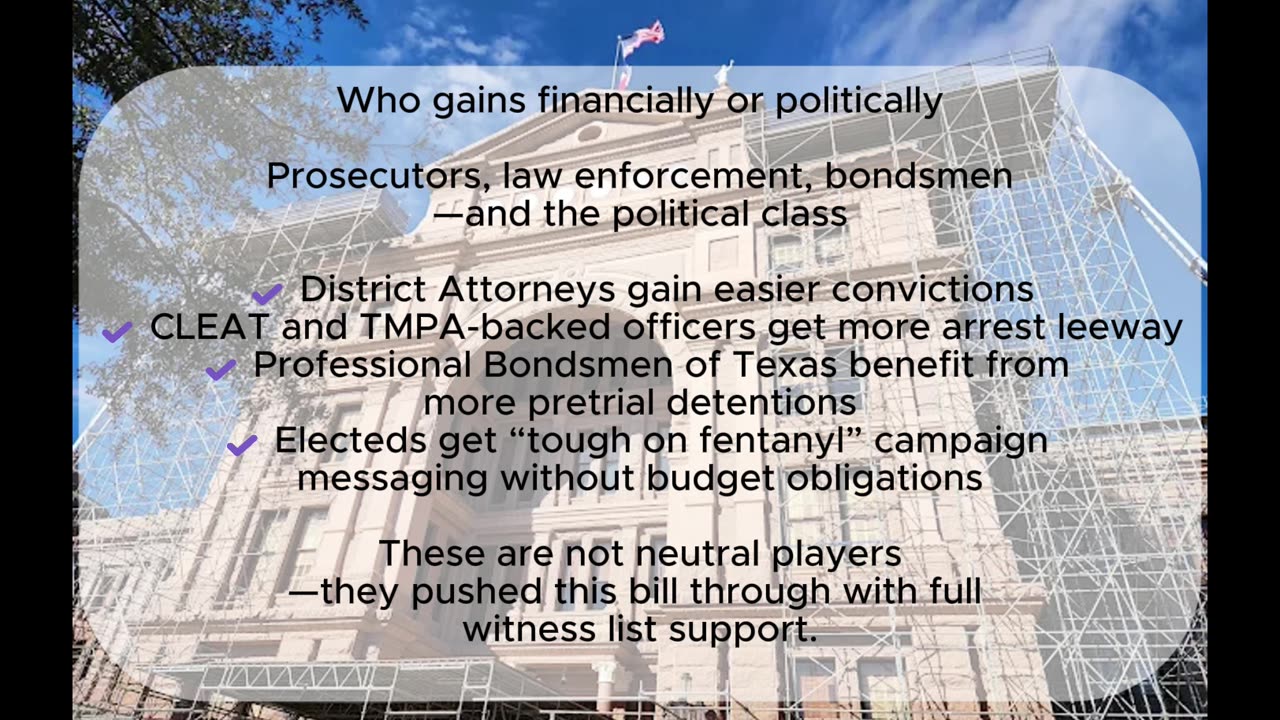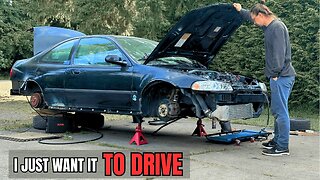Premium Only Content

HB 166
"🔴 HB 166 – When Safety Meets Presumption, Who Gets Caught in the Crossfire?
Texas just passed HB 166...and on the surface, it looks like a straightforward, no-nonsense response to the fentanyl crisis.
And to be fair, the intent sounds right:
If a child, elderly person, or disabled individual tests positive for fentanyl, and you were nearby using, manufacturing, or even just possessing it? That’s endangerment. You’ll face criminal charges. No argument...protecting vulnerable Texans matters.
But here’s what this bill actually does under the hood:
🔸 It creates a legal presumption of guilt for endangerment, just based on proximity and a positive drug test in someone else.
No need to prove intent. No need to show reckless behavior. If you're in the area, you're presumed guilty...and it's up to you to prove otherwise.
🔸 There’s no carveout for legally prescribed fentanyl...like in hospice or pain management.
A caregiver following doctor’s orders could still be arrested if trace exposure shows up in a dependent’s system.
🔸 There’s no flexibility for poverty or housing conditions.
If you live in a low-income apartment where someone else is using fentanyl nearby, and your child is exposed through shared surfaces or airspace? You’re on the hook...whether you used it or not.
🔸 There’s no check-and-balance requirement before charges are filed.
No agency review. No third-party assessment. Just the test result and your presence.
Who’s behind this?
✔️ Law enforcement unions (CLEAT, TMPA, Sheriff’s Associations)
✔️ District Attorneys from Tarrant, Comal, and rural judicial districts
✔️ Professional Bondsmen of Texas
✔️ Victim advocacy groups like Texas CASA and AARP Texas
And who benefits?
✅ Prosecutors...who get easier convictions without proving intent
✅ Police...who can act on test results, not full investigations
✅ Bondsmen...who profit from pretrial detentions of the accused
✅ Political actors...who get to say they’re “tough on fentanyl” without investing in addiction recovery or housing reform
And who’s at risk?
❌ People in recovery who follow their treatment plan but can’t afford to live alone
❌ Parents or caregivers in shelters or transitional housing where others might be using
❌ Low-income families in shared spaces where drug use by others can still create exposure
❌ Medically fragile patients using doctor-prescribed fentanyl who are now legally vulnerable
This law punishes exposure...but not always recklessness.
It punishes proximity...but not always intent.
And in doing so, it shifts power...from courts to prosecutors, from communities to the state, from context to presumption.
The question isn’t whether we should protect kids and elders from fentanyl. Of course we should.
The question is how we do that without criminalizing people for where they live, who they’re related to, or whether they’re poor.
Because when you write laws that presume guilt without nuance...you don’t just stop the bad actors.
You catch the desperate, the recovering, the trapped, and the voiceless right alongside them.
📬 Bottom line: HB 166 was written to go after dangerous behavior...but it may go after people trying to survive. And unless it’s amended to build in safeguards, it risks turning safety into a tool of overreach.
Quick ask, y’all...likes help the algorithm, but shares are what get the truth out.
If this bill affects you, your kids, your patients, your neighbors...please share it.
Too many Texans don’t know what’s being signed into law. And if we don’t share it, they won’t hear it. These bills move quietly. The consequences don’t.
It’s not about going viral. It’s about making sure the people who need to know...do know.
So if this post made you pause, think, or get fired up… don’t just like it. Send it. Share it. Say something.
🔴 #HB166 #FentanylCrisis #PolicyWithConsequences #TexasLegislation #WatchTheDetails"
-
 LIVE
LIVE
Total Horse Channel
21 hours agoAMHA 2025 9/20
1,603 watching -
![Mr & Mrs X - [DS] Created Antifa To Push An Insurgency In This Country - Ep 8](https://1a-1791.com/video/fww1/f9/s8/1/k/f/O/j/kfOjz.0kob-small-Mr-and-Mrs-X-DS-Created-Ant.jpg) 1:02:13
1:02:13
X22 Report
3 hours agoMr & Mrs X - [DS] Created Antifa To Push An Insurgency In This Country - Ep 8
103K25 -
 1:13:24
1:13:24
Wendy Bell Radio
7 hours agoPet Talk With The Pet Doc
18.5K34 -
 1:19:30
1:19:30
Game On!
1 day ago $9.13 earnedCollege Football Week 4 Betting Preview!
124K4 -
 26:04
26:04
Artur Stone Garage
4 days ago $1.00 earned$500 Civic: Will It EVER Drive Without Breaking Down?
13.1K3 -
 31:44
31:44
SouthernbelleReacts
2 days ago $1.79 earned“E.T. Phone Home! 🛸 Emotional Mom Style Reaction to E.T. the Extra-Terrestrial (1982)”
23.9K3 -
 20:10
20:10
JohnXSantos
1 day ago $0.71 earnedI Built a FAKE Luxury Brand With $100 In 7 Days
17.6K1 -
 25:24
25:24
marcushouse
4 hours ago $2.05 earnedStarship Test Trouble… and Block 3 Finally Unveiled! 🤯
24K6 -
 33:10
33:10
Vedic compatability astrology
5 days ago"The mystery of Austin Muhs Explained"
7.31K -
 1:13:26
1:13:26
Squaring The Circle, A Randall Carlson Podcast
10 hours agoSaving The Bees and Healing The Planet!
15.3K1